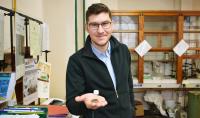An idea for effective removal of the radioactive element
How can the toxicity of cesium, which is frequently used but dangerous both for people and the environment, be dealt with? What can help are nanomaterials containing sumanene. Artur Kasprzak, PhD, from the Faculty of Chemistry at the Warsaw University of Technology is currently working on it. He is the only researcher in the world who specializes in such a use of this compound.
High concentrations of the cesium 137Cs isotope are mostly found in areas where nuclear power plant accidents took place. This was the case, for example, in Fukushima, where it had serious consequences.
– Japan is an island country, so the problem was bigger than in Chernobyl – toxic cesium got into the water, including groundwater, to the areas where rice is grown – says Artur Kasprzak, PhD – We also cannot ignore the existence of marine currents and the impact of this radioactive element on fish.
In addition, it should be kept in mind that once the cesium isotope is released into the environment, it will stay there for at least 30 years.
However, the problem with cesium concerns not only disaster sites, but the whole world, because the element (in various forms) is used, among other things, in the treatment of cancer, the pharmaceutical industry, and even in dietary supplements.
In search of practical application
Researchers began to look for ways to remove cesium salts from aqueous solutions. Here, two main difficulties have emerged – low selectivity of the developed solutions (they remove not only cesium but also desired elements like potassium and magnesium), and high disposal costs.
Kasprzak, PhD, developed a new material – consisting of magnetic carbon nanoparticles with a cobalt core modified with sumanene.
– I became interested in sumanene in 2019 during a research internship at Osaka University in Japan, while working in the team of Prof. Hidehiro Sakurai – He was the one who discovered this compound in 2003 – says Kasprzak, PhD – I noticed that most of the research on sumanene is mainly structural and synthetic. It lacked information on practical application. I was only able to find a mention of sumanene's selective interaction with cesium cations.
This was the beginning of further research.
It works!
Kasprzak, PhD, decided to make practical use of this effect of sumanene by developing a magnetic cesium nanoadsorbent.
– The material absorbing cesium is added into the contaminated water – says the PW researcher. – Its magnetic properties allow for quick, easy, and accurate separation of the material from the solution. If we add material without these properties to contaminated water, we must separate it in a different way, for example by draining or centrifuging. It's easy in the kitchen, but not in the industry. Magnetic properties make the whole process easier. Simply holding a magnet against the vial causes the material and, along with it, the cesium, to separate from the solution.
In cooperation with Prof. Hidehiro Sakurai’s team from Japan, Kasprzak, PhD, conducted research to verify the effectiveness of his solution. It clearly determined that it enables the removal of cesium from the solution, with tests using sodium and potassium as interferers confirming the selectivity of the method.
Successful tests have also been conducted using cesium salt-containing aqueous effluents produced during the development of the anticancer drug precursor as well as effluents from regular organic syntheses. The research also confirmed that the produced material can be used repeatedly, has a high adsorption capacity, and can be easily regenerated – using only a small amount of water. This reduces the volume of cesium-containing effluent and makes it possible to reduce the costs associated with storing or disposing of waste.
The project "Magnetic nanoadsorbents containing sumanene for selective and effective removal of cesium salt from aqueous or organic solutions" is financed under the "Excellence Initiative – Research University" program implemented at the Warsaw University of Technology. The idea received support in the competition of the POB Research Centre Materials Technologies.








